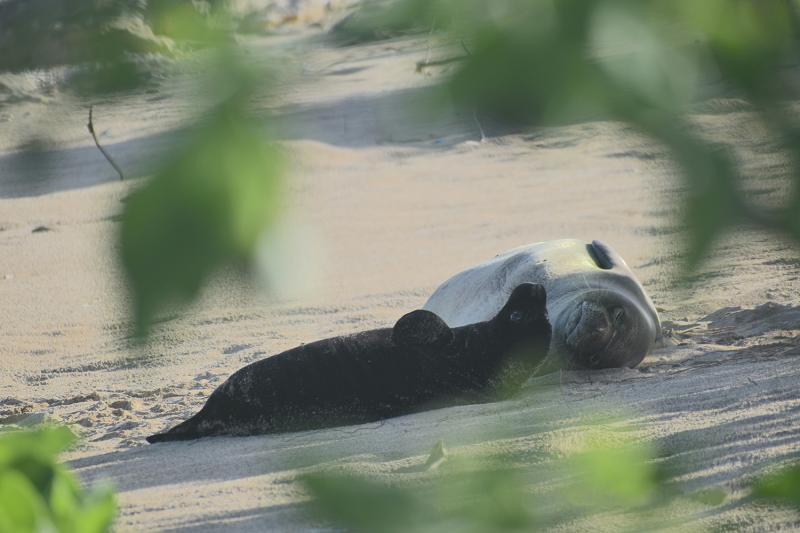
Famous Waikiki pup gives birth outside of the spotlight
by NOAA Fisheries 28 Feb 2023 19:25 UTC

Hawaiian monk seal RJ58 (Kaimana) and her pup © Hawaii Marine Animal Response (Permit #24359)
Nearly 6 years ago, Hawaiian monk seal RH58 (Rocky) surprised us all and gave birth to a female pup on a busy, high-traffic beach in Waikiki. Now, that world-famous pup RJ58 (Kaimana) is raising a pup of her own, but in a much quieter location.
On January 28, 2023, Kaimana gave birth to the first pup of 2023 in the main Hawaiian Islands. Peak pupping season usually begins in spring, so this early start is a welcome surprise.
Our partners at Hawaii Marine Animal Response (HMAR) have been on site each day monitoring the pair since Kaimana gave birth. They were even there to witness the birth!
"We've been observing a lot of nursing and swimming behavior from the pair," said Jon Gelman, HMAR president. "We'll continue to be in the area until after Kaimana leaves, and the pup begins to venture off by itself."
HMAR has been busy off the beach, too, working with Kahuku Elementary School's fifth grade class to gift the pup a Hawaiian name. The students selected the name U'i Mea Ola, or U'i for short. It means "beautiful survivor." One of the reasons the students gifted this name was that the pup was born safely during the moon phase 'Ole Ku Lua, known for high tides and rough conditions.
"Our goal with each naming is for the students, teachers and surrounding communities to learn a bit more about Hawaiian monk seals, their importance and conservation," said Emily Greene, HMAR's education manager. "In addition, we hope that these students feel a sense of kuleana, or responsibility, to care for and conserve not only the pup they name but all monk seals and marine life."
From city sights to quieter nights
When Kaimana was born in June 2017, the newborn pup quickly caught the attention and the hearts of people across Hawaii and beyond.
She was the first Hawaiian monk seal (that we know of) to be born on a popular Waikiki beach. The location, however, posed a number of risks to the young pup's future. So after extensive discussion and analysis, NOAA and partners relocated Kaimana when Rocky weaned her. The move enabled Kaimana to grow up in a more remote location, in the company of other wild monk seals and away from high levels of human interaction.
"With any relocation, we always strive for the best possible outcome for these endangered seals," said Kilali Ala'ilima Gibson, NOAA Fisheries' O'ahu marine wildlife response coordinator. "And with Kaimana, we're excited to see that not only is she doing well, but she's opted to give birth on a much quieter beach from where she was born."
That news is especially noteworthy because Hawaiian monk seals often return to the beaches where they were born to give birth.
Pupping season ahead
With U'i kicking off this year's pup cohort, we anticipate seeing more Hawaiian monk seal births following soon.
"We're gearing up for what we expect to be another busy pupping year!" Gibson said. "We're looking forward to monitoring each new pup's development with our partners, and sharing information with the community on how we can all do our part to help keep these pups safe and healthy."
Hawaiian monk seals give birth throughout the year, but peak pupping season is typically spring through summer (March through August).
NOAA works with volunteers and provides competitive grant funding to partners like HMAR and The Marine Mammal Center to help oversee the day-to-day monitoring of monk seals in Hawaii. These partners set up perimeters around mom-pup pairs and monk seals in busy locations to guide beachgoers on how much space to give nursing and resting seals.
"Our volunteers work hard to educate the public on the importance of these animals, and to ensure the seals have a place to rest undisturbed," Gelman said. "We appreciate the community's support respecting the perimeters and signs in place, and reporting seal sightings."
How can you help mother seals and pups
If you run into mom and pup pairs (or monk seals in general) here's how you can keep the seals—and yourself—safe:
- Give them space: Keep a respectful distance of at least 150 feet from mom-pup pairs, and at least 50 feet from all other monk seals—on land and in the water.
- Swim elsewhere: If a mom-pup pair is present, swim at a different location. Hawaiian monk seal mothers can be protective of their pups and have bitten people in the past.
- Keep your dogs leashed: Pets can transmit diseases to wild animals and vice versa. Also, stressful dog encounters may cause a seal to react aggressively or leave the area.
- Report sightings: If you spot a seal, call the statewide NOAA Marine Wildlife Hotline: (888) 256-9840.